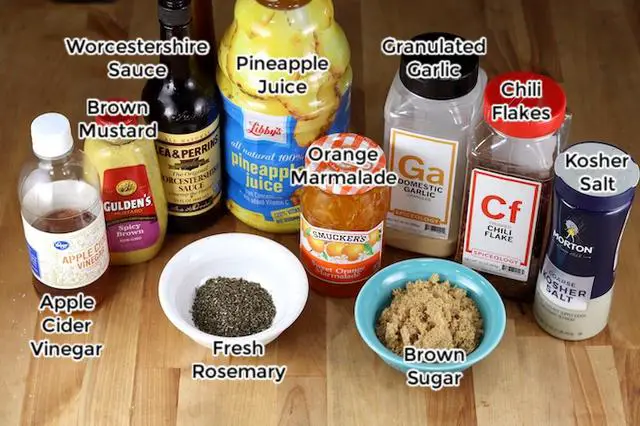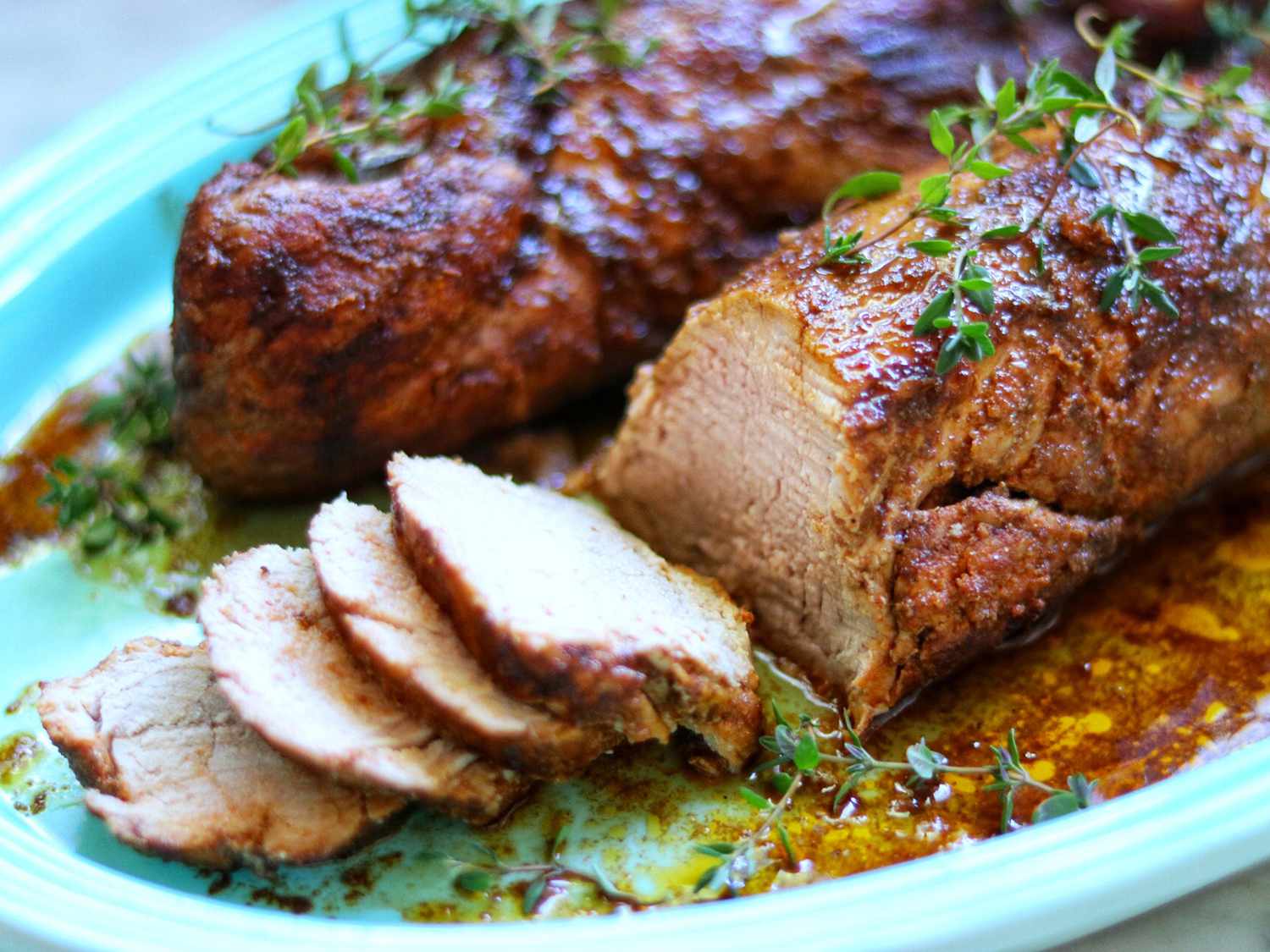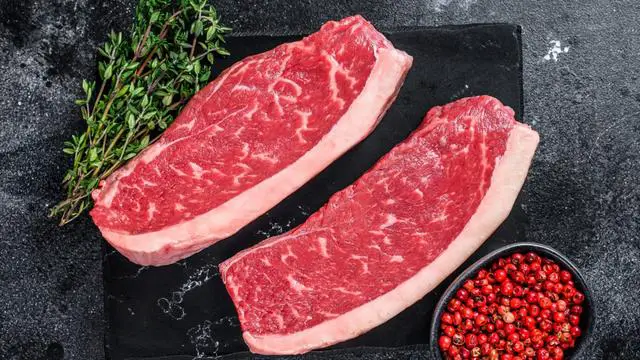
Discover the Rich Delights of Fatty Cuts: Indulge in Juicy, Flavorful Beef that Melts in Your Mouth! Experience the Perfect Balance of Succulence and Tenderness with Our Premium Selections.
5 Fattiest Cuts of Beef Steak: The Best Options

Contrary to popular belief, some of the most popular cuts of steak are actually quite fatty. Cuts of steak that have high levels of intramuscular fat (marbling) are typically found on the dorsal area of the steer. Good examples include popular cuts like the Ribeye or New York strip steak.
With all that said, there are a number of cuts of steak that are “fatty” and tender, most of which come from the dorsal area of the steer. The chuck eye steak comes from the beef chuck roll and lies beneath the blade bone – it’s an extension of the beef rib/ribeye roll. On a beef carcass, the chuck primal is separated from the rib primal at the 5th and 6th rib. Chuck eye steaks contain wonderful marbling that’s common in rib steaks, but also contain larger complexus muscles, which are surrounded by swaths of fat.
To start, a true rib “eye” steak is just the longissimus dorsi muscle – this trimmed version is often called a ribeye filet. Today though, rib steaks are collectively called “ribeye” steaks regardless of muscle composition. Steaks taken from this section have varying degrees of different muscles – namely the rib eye, the cap, and complexus.
Skirt steak used to be considered offal (refuse/waste) or organ meat. Today, this cut of beef is considered one of the best on the entire animal. From a single steer, there are two inside skirt steaks and two outside skirt steaks. Both are long (20-24 inches) and thin (2-4 inches across). Unlike flank steak, which is rather lean, skirt steak is quite fatty.
NY Strip Steak comes from the loin primal, more specifically, the short loin sub-primal. Similar to the ribeye steak, the NY Strip Steak features the longissimus dorsi muscle; As we learned above, this is the “eye” of the ribeye steak. While the New York Strip features the same muscles as a rib eye steak, there are differences based how the steer uses these muscles.
T-bone steak is probably the most recognizable cut of steak – it quite literally features a T-shaped bone within the lean meat. The t-bone steak comes from the short loin sub-primal – at the front of the loin primal. The t-bone steak is actually comprised of two muscles that can be further broken down into two steaks – the New York Strip and the tenderloin.
What is “Fat” Found in Steer?
Steers, or cows, have various types of fat found in their bodies. The two main types of fat that are important to consider when it comes to beef steaks are intramuscular fat and intermuscular fat. Intramuscular fat, also known as marbling, refers to the visible storage of lipids (fat) between muscle fibers. This type of fat adds flavor and tenderness to the meat. Intermuscular fat, on the other hand, is fat that is located between muscle groups.
The grading of beef is an important factor when it comes to determining the fat content of different cuts of steak. In the United States, beef is graded based on its intramuscular fat content. The USDA assigns one of three grades to beef: select, choice, and prime. The degree of marbling in the meat is the primary determinant for the quality grade. While a ribeye steak naturally has more fat than a strip steak, their grading dictates their intramuscular fat content. This means that a select grade ribeye will have less fat than a choice or prime grade New York strip.
There are several cuts of steak that are considered fatty and tender, most of which come from the dorsal area of the steer. One example is the chuck eye steak, which comes from the chuck roll beneath the blade bone. It contains wonderful marbling similar to rib steaks and has a more affordable price compared to typical ribeye steaks.
Rib steaks themselves are also popular and feature varying degrees of different muscles such as the cap (spinalis dorsi) and the eye (longissimus dorsi). These muscles have significant marbling, adding tenderness and succulence to the steak.
Skirt steak, once considered offal or organ meat, is now highly regarded as one of the best cuts on the animal. It comes from the diaphragm muscle attached to ribs 6-12 on the underside of the short plate. Skirt steak is quite fatty and must be cooked over high heat to medium rare for optimal tenderness.
The New York Strip steak, which comes from the loin primal, features the longissimus dorsi muscle like a ribeye steak but with less marbling and external fat. It is less tender but has a beefier flavor.
T-bone steak is recognizable for its T-shaped bone and comes from the short loin sub-primal. It consists of two muscles that can be further broken down into two steaks – the New York Strip and the tenderloin. The tenderloin side is leaner while the strip side is fattier but less tender.
Understanding Beef Grades
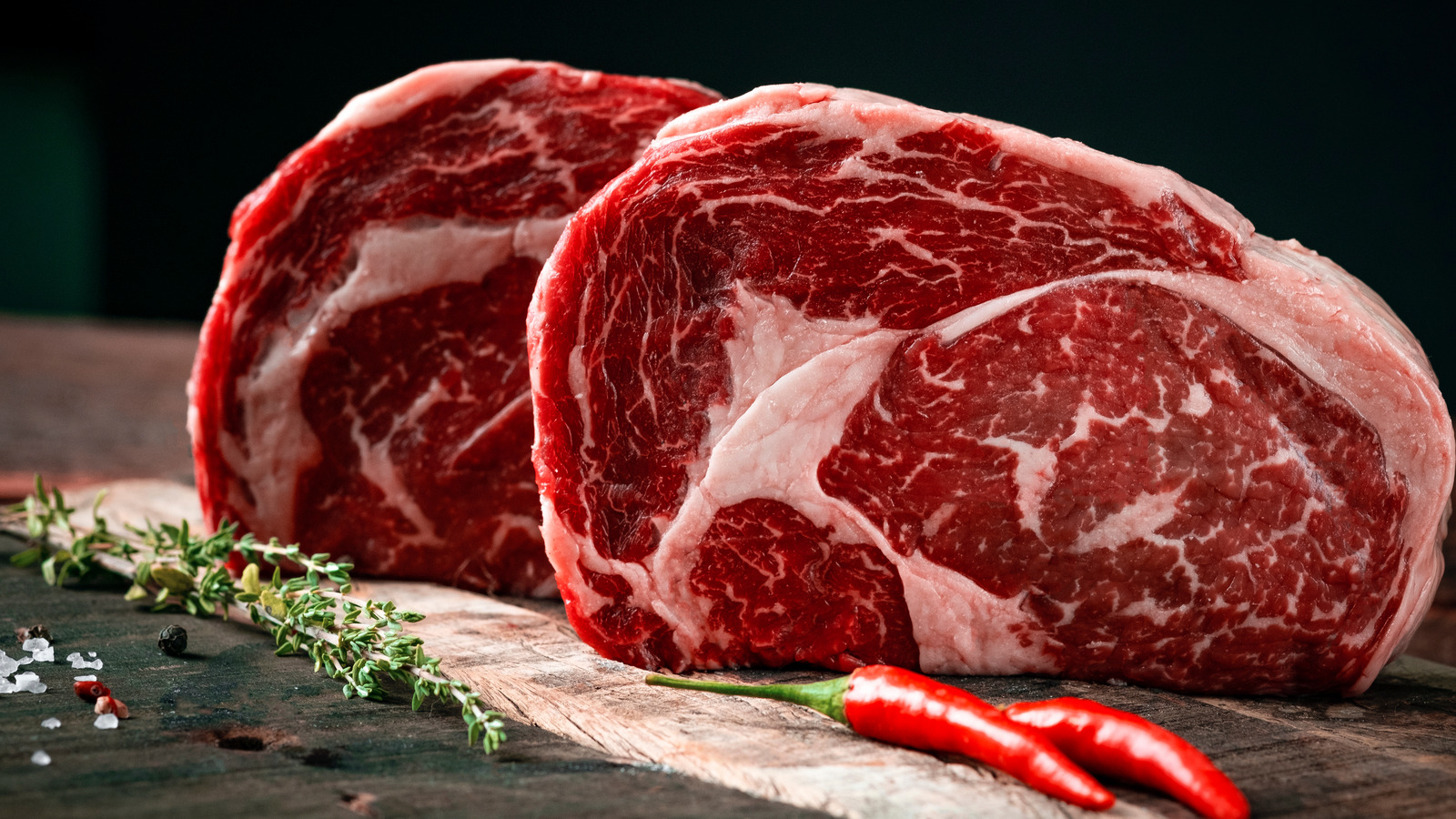
Understanding Beef Grades
Beef grading is an important factor to consider when it comes to understanding the fat content of different cuts of steak. In the United States, beef is graded by visually and electronically appraising the intramuscular fat content. The degree of marbling, or the presence of fat within the muscle fibers, is the primary determinant for the “quality” grade assigned by the USDA.
There are three grades assigned to beef – select, choice, and prime. Select grade beef has the lowest level of marbling and therefore lacks juiciness and flavor compared to higher grades. Choice grade beef has less marbling than prime but still offers significantly better flavor and tenderness compared to select. Prime grade beef has the highest level of marbling, resulting in exceptional tenderness, juiciness, and rich flavor.
Different cuts of steak can have varying levels of intramuscular fat content depending on their location on the steer. For example, a ribeye steak naturally has more fat than a strip steak, but their grading will dictate their exact fat content. A select grade ribeye will have less fat than a choice or prime grade New York strip.
Overall, understanding beef grades can help you make informed decisions about which cuts of steak are best suited for your taste preferences and dietary needs.
Fattiest Cuts of Steak
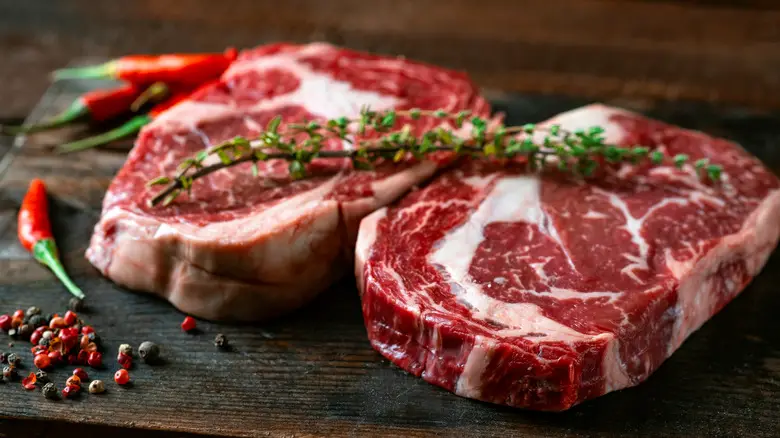
Contrary to popular belief, some of the most popular cuts of steak are actually quite fatty. Cuts of steak that have high levels of intramuscular fat (marbling) are typically found on the dorsal area of the steer. Good examples include popular cuts like the Ribeye or New York strip steak.
There are several types of fat found on a steer – subcutaneous, intermuscular, intramuscular, intercostal, etc. The main types of fat that are worthy of consideration with beef steaks are intramuscular and intermuscular fat. Intramuscular fat is commonly called “marbling.” It’s the visible storage of lipids (fat) between muscle fibers. Intermuscular fat is just as it sounds – fat that is quite literally between (inter) muscle groups.
The degree of marbling is the primary determinant for the “quality” grade assigned by the USDA to beef. Different parts of the steer are more prone to developing greater levels of intramuscular fat. While a ribeye steak will naturally have more fat than say a strip steak, their grading dictates intramuscular fat content. Meaning, a select grade ribeye will have less fat than a choice or prime grade NY Strip.
1. Chuck Eye Steak
The chuck eye steak is a fatty and tender cut of beef that comes from the chuck roll, beneath the blade bone. It is an extension of the beef ribeye roll. This cut contains wonderful marbling, similar to rib steaks, and also includes larger complexus muscles surrounded by fat. The complexus muscle is one of the most tender on the animal, comparable to the highly prized ribeye cap or spinalis dorsi. Despite its tenderness and marbling, chuck eye steak is relatively inexpensive compared to typical ribeye steaks.
Ribeye steak is one of the most popular cuts on the entire animal. It comes from the rib primal, separated from the chuck primal at ribs 5 and 6. Rib bones 6-12 can be shortened or removed to create different styles of rib steaks. Ribeye steaks have varying degrees of different muscles, including the cap or spinalis dorsi muscle and the longissimus dorsi muscle (the “eye”). These muscles have significant marbling that adds tenderness and succulence to the steak.
Skirt steak used to be considered refuse or organ meat, but today it is regarded as one of the best cuts on the animal. There are two inside skirt steaks and two outside skirt steaks per steer. Skirt steak comes from the diaphragm muscle attached to ribs 6-12 on the underside of the short plate. Unlike other beef steaks, skirt steak is naturally tough with large muscle fibers. However, it can be tenderized through marination with ingredients like pineapple that contain enzymes capable of breaking down collagen.
NY Strip steak comes from the short loin sub-primal, specifically the longissimus dorsi muscle. While it features similar muscles to ribeye steak, it has less marbling and external fat due to the fact that the short loin primal is used more often than the rib. As a result, NY Strip steak is less tender and chewier than ribeye steak. It has a beefier flavor but lacks the richness of fat. The presence of back fat on NY Strip steaks adds flavor during cooking.
T-Bone steak is easily recognizable due to its T-shaped bone within the lean meat. It comes from the short loin sub-primal at the front of the loin primal. The T-Bone steak consists of two muscles that can be further divided into two steaks – New York Strip and tenderloin (filet mignon). The tenderloin side of the T-bone is less beefy but exceptionally tender, while the strip side is more beefy but less tender. This cut offers a combination of lean and fatty meat.
2. Ribeye Steak
Ribeye steak is one of the most popular and flavorful cuts of beef. It is known for its high marbling, which adds tenderness and juiciness to the meat. The ribeye comes from the rib primal of the steer, specifically the longissimus dorsi muscle. This muscle is located along the dorsal area and has a generous amount of intramuscular fat, resulting in excellent marbling.
When it comes to grading, ribeye steaks are typically assigned a higher grade due to their superior marbling. A choice or prime grade ribeye will have more fat than a select grade NY Strip, making it richer in flavor. The ribeye steak is often considered one of the fattiest cuts of beef steak due to its high fat content, but this also contributes to its exceptional taste.
3. Skirt Steak
Skirt steak used to be considered offal or organ meat, but today it is considered one of the best cuts of beef. It comes from the diaphragm muscle and is attached to ribs 6-12 on the underside of the short plate. Skirt steak is long and thin, with a loose grain structure. However, it is not naturally tender and has large muscle fibers, making it a tough cut of meat.
To make skirt steak tender, it is typically marinated with a fruit that can tenderize meat, such as pineapple which contains an enzyme called bromelain that breaks down collagen. The marinade helps to further tenderize the meat and enhance its flavor. Unlike flank steak, skirt steak is quite fatty and must be cooked by searing over high heat and served rare or medium rare. Cooking it above medium-rare will make it tough and dry.
Slicing skirt steak into smaller strips against the grain results in a tender cut of meat that can be enjoyed in various dishes.
4. New York Strip Steak
The New York Strip Steak comes from the loin primal, specifically the short loin sub-primal. It features the longissimus dorsi muscle, which is also known as the “eye” of the ribeye steak. However, compared to a ribeye steak, the New York Strip has less marbling and external fat because the short loin primal is used more frequently by the steer. As a result, the New York Strip is slightly less tender and chewier than a ribeye steak.
While it may be less marbled, the New York Strip still offers a beefy flavor and is considered more “beefy” than “rich” due to its lower fat content. It’s important to note that there will typically be a band of back fat on a New York Strip steak, but this fat is not meant to be eaten and instead adds flavor during cooking.
5. T-Bone Steak
The T-bone steak is one of the most recognizable cuts of steak, featuring a T-shaped bone within the lean meat. It comes from the short loin sub-primal, located at the front of the loin primal. The T-bone steak is actually made up of two muscles that can be further divided into two steaks – the New York Strip and the tenderloin. The New York strip is on the long side and the tenderloin is on the short side.
When the tenderloin is removed, what remains after the filet mignon is removed is known as beef tenderloin. In American butchery, T-bone and Porterhouse steaks are created by keeping both the tenderloin and strip together. This means that when you have a T-bone steak, you get both tenderloin meat (which is fairly lean) and strip steak (which is somewhat fatty).
On a T-bone steak, the tenderloin side is less beefy but extremely tender, while the strip side is more beefy but less tender. This combination of textures and flavors makes T-bone steak a popular choice for many steak lovers.
Overall, while T-bone steaks may not have as much marbling as ribeye steaks, they still offer a delicious combination of tenderness and flavor.
In conclusion, fatty cuts of beef can add flavor and juiciness to meals, but they should be consumed in moderation due to their higher fat content. Choosing leaner cuts and incorporating a balanced diet is essential for maintaining overall health and well-being.
Learn More About Grilling
If you want to learn more about grilling, check out these other helpful resources!



